Journal of Modern Physics
Vol.5 No.3(2014), Article ID:43129,5 pages DOI:10.4236/jmp.2014.53021
Generation of Short Wavelength in Up-Conversion of Tm+3 Doped Fluoride Glass and Its Application in Fiber Lasers
1Department of Physics, Taif University, Taif, KSA
2Faculty of Science (Physics), Helwan University, Helwan, Egypt3Department of Physics, Faculty of Science, Al Jouf University, Al-Jawf, KSAEmail: *Redaagmy@yahoo.com
Copyright © 2014 Reda Mohamed El-Agmy et al. This is an open access article distributed under the Creative Commons Attribution License, which permits unrestricted use, distribution, and reproduction in any medium, provided the original work is properly cited. In accordance of the Creative Commons Attribution License all Copyrights © 2014 are reserved for SCIRP and the owner of the intellectual property Reda Mohamed El-Agmy et al. All Copyright © 2014 are guarded by law and by SCIRP as a guardian.
Received November 30, 2013; revised December 29, 2013; accepted January 27, 2014
Keywords:Fluoride Glass; Up-Conversion Pumping; Spectroscopy
ABSTRACT
We report on the experimental study of the visible and ultraviolet (UV) fluorescence emission in a (1% molar) Thulium (Tm+3)-doped Zirconium fluoride glass sample. From red at 650 nm, blue (453 & 480 nm) and UV at 365 & 284 nm, have been observed under excitation of a Nd:YAG laser at 1.064 µm. The responsible up-conversion mechanisms are investigated based on experimental data. The related problem of photo-degradation associated with formation of color centers is also addressed.
1. Introduction
Heavy-metal fluorozirconate glasses and fibers are finding increased interest for the compact devices that generate short wavelengths in the visible and UV region. The importance for such emissions is needed for many applications, such as data storage, medical applications like photodynamic therapy, for pumping of solid state lasers (e.g. Cr:LiSAF) and all color display [1-4].
Among rare earth (RE) ions, Tm+3 showed a versatile candidate that converts low-energy infrared photons to high-energy photons in the visible and ultraviolet spectral under up-conversion processes [5-8]. The first upconversion-pumped visible laser was demonstrated in a Tm+3- doped ZrF4-BaF2-LaF3-AlF3-NaF (ZBLAN) fiber at 455 nm (1D2®3F4) and 480 nm (1G4®3H6) with additionally some UV fluorescence at 288 nm (1I6®3H6) [9]. Spontaneous emission has also been observed from the Tm+3 1I6 at 290 nm in ZBLAN, which requires the energy of five 1140 nm pump photons [10]. Unstable laser operation at 284 nm (1I6®3H6) is demonstrated in Tm+3-doped ZBLAN under up-conversion pumping [11]. As presented in Ref. [11], the obtained UV laser at 284 nm was shut down after a few minutes of operation due to photo-degradation problem. Photo-degradation is the absorption of visible and short wavelengths or so called color centre problem. Stability and power scaling can be reached with the improvement of the ZBLAN material through the modulation of the component of the fiber, introducing other ions into the core of the fiber to preclude the photo-degradation effect [7]. Additionally, fibers with small numerical aperture (NA) by adjusting the refractive indices of the fiber core and cladding may also reduce the photo-darkening effect [2]. Usually, this effect can be removed almost entirely by circulating blue light or wavelength of 514 nm through the fiber core [2,7]. This problem of photo-degradation associated with formation of color centers is solved temporally by circulating 514 nm through the fiber core as reported in ref. [7].
In this paper we reported on the experimental study of the excitation and emission mechanisms of fluorescence in a (1% molar) Thulium (Tm+3)-doped Zirconium fluoride glass sample. Ultra-violet (at 365 nm & 284 nm), visible (at 453, 480 and 650 nm) radiation was observed under excitation at 1.064 µm. The responsible up-conversion mechanisms are investigated based on experimental data. The photo-curing of the photo-darkening effect is also addressed.
2. Experiment
The (Tm+3)-doped Zirconium fluoride glass sample used in the experiment is (1% molar) 5 × 10 × 15 mm and was excited by a Nd:YAG laser (Laserlabcomponets IR CWL 1064-3). The experimental arrangement is shown in Figure 1. The pump laser is a Nd:YAG laser operated at 1.064 µm. The beam of the Nd:YAG laser is chopped mechanically and focused onto the glass sample by a 20×-microscope objective. A lens with a focal length of 25 mm collects the fluorescence of the glass sample and directs it onto the entrance slit of a monochrometer 1200 groves/mm grating monochromator (Newport oriel 74125) blazed for 500 nm with a resolution set to 0.8 nm. Photodiodes (SicB-type, 200 - 1100 & InGaAs 1200 - 2600 nm Thorlabs), a lock-in amplifier (Stanford SR830 DSP), digital oscilloscope (Tektronix TDS3084B) and power meter were employed to record the temporal behavior of the emitted spectrum and its intensity profile.
3. Results and Discussion
The absorption spectrum of the glass sample at room temperature is presented in Figure 2. A spectrophotometer (Jasco 670) was used for measurements, the spectrum covering the spectral region 200 - 2000 nm and identified all the J levels of Tm+3.
Table 1 lists peak position bands of the absorption spectrum of the sample at room temperature covering the spectral region 200 - 2000 nm. The spectrum consists of several groups corresponding to transitions from the ground state 3H6 to the excited state of Tm+3.
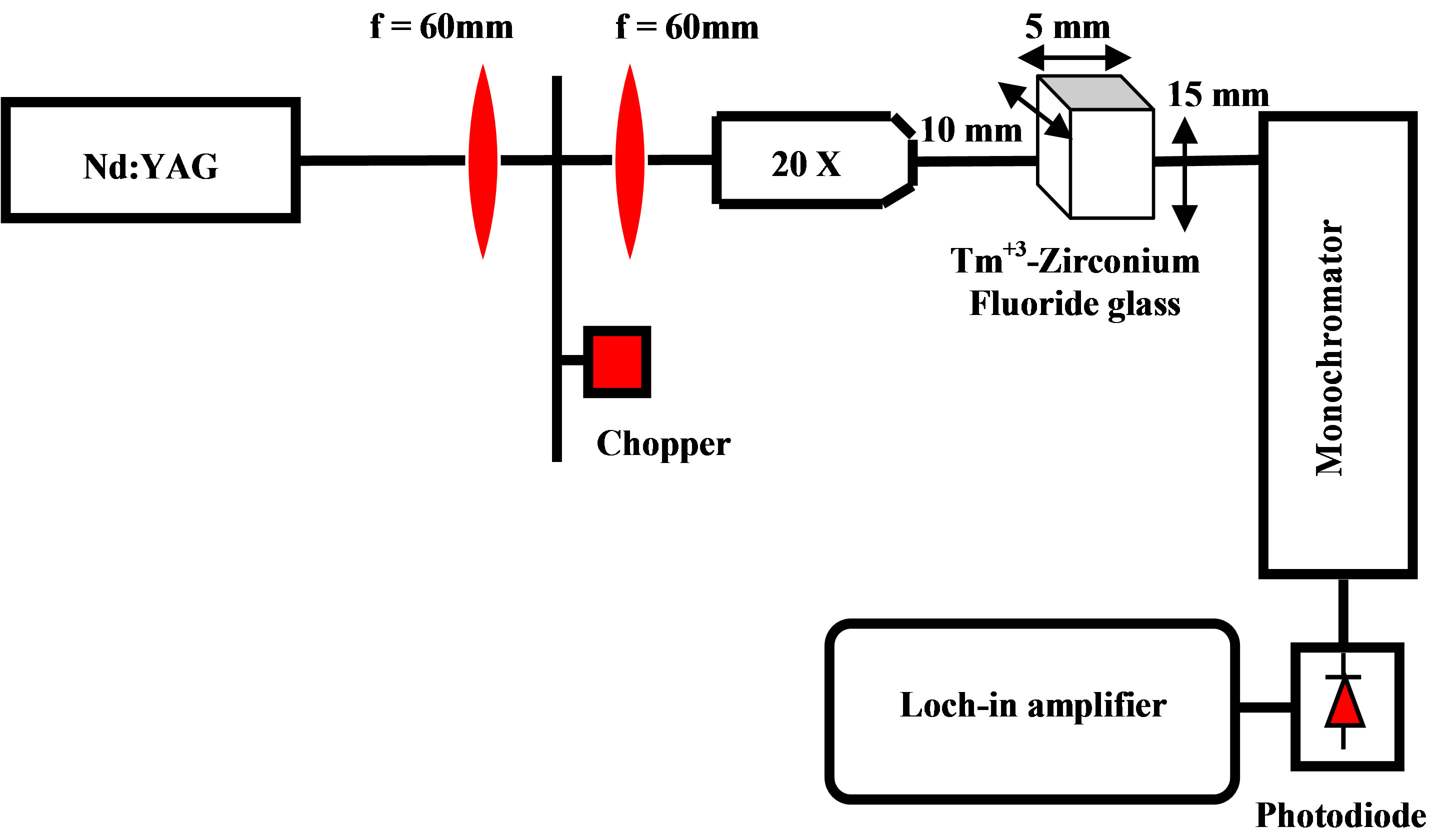
Figure 1. Experimental setup.
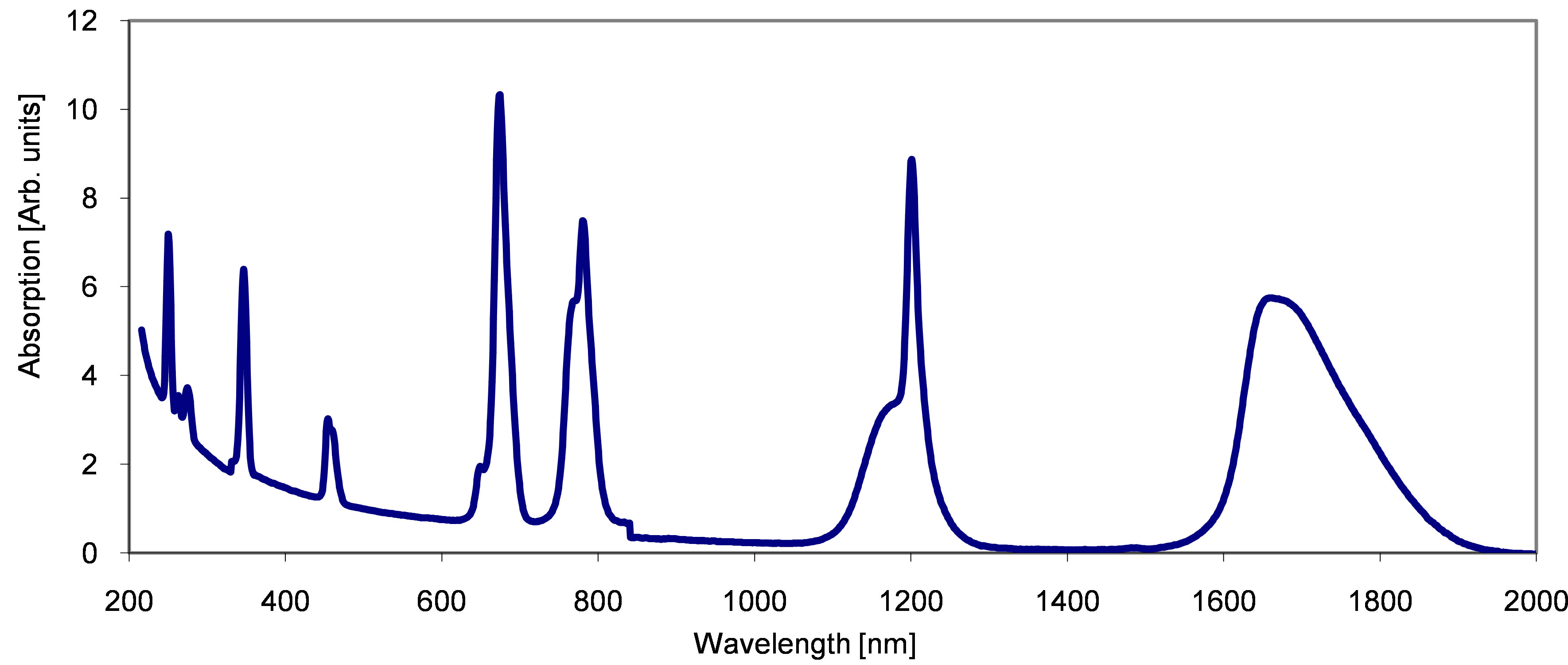
Figure 2. Absorption spectrum of 1% molar Tm+3-doped zirconium fluoride glass.
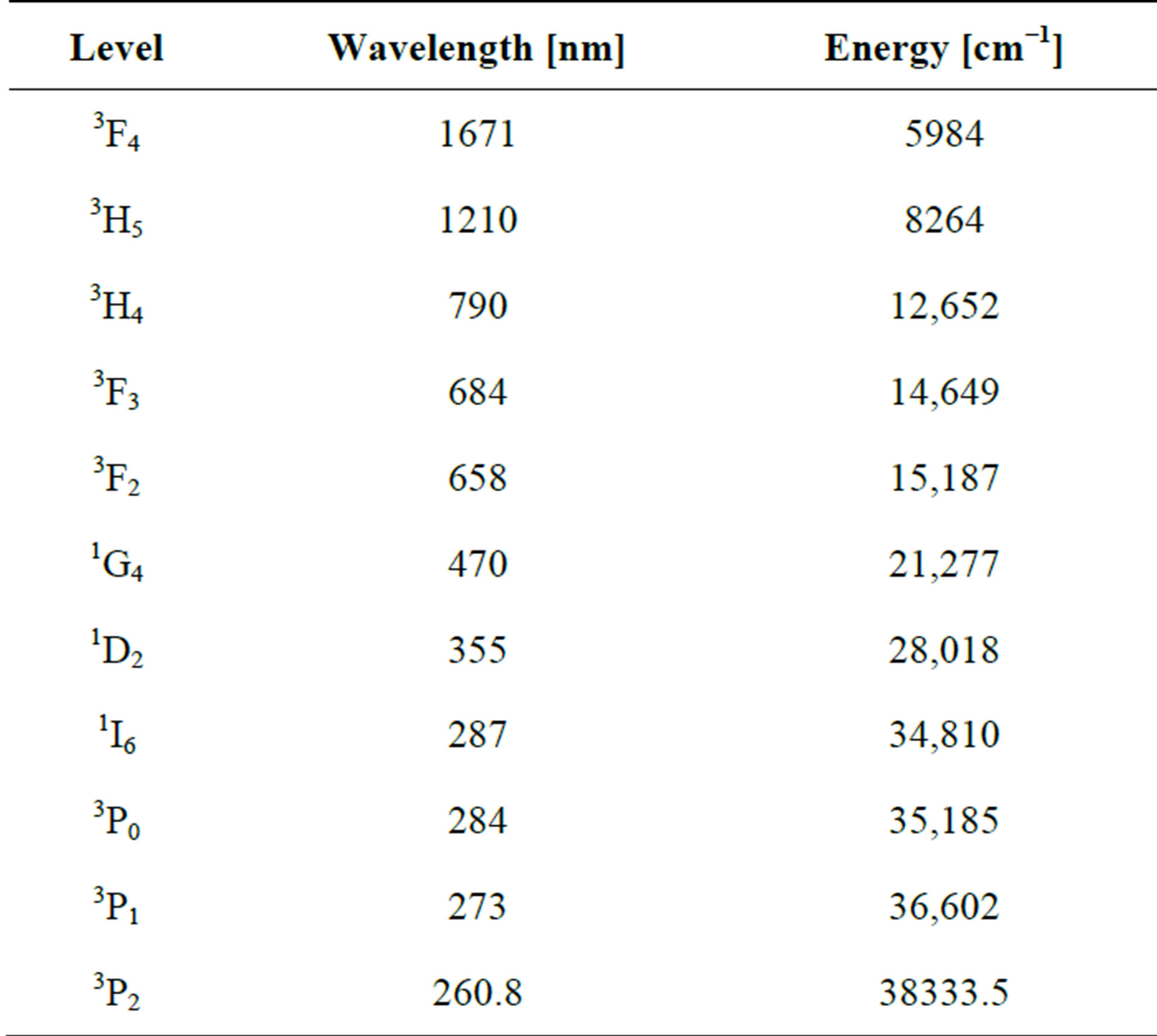
Table 1. Peak positions of absorption bands in Tm+3: zirconium fluoride glass.
The excitation scheme is shown in Figure 3. In upconversion processes, usually three processes are considered. One is the excited state absorption (ESA) process, which consists of two consecutive excitation steps on a single ion. The other one is the energy transfer up-conversion (ETU) process, in which two ions in an intermediate state interact resulting in that the energy of an ion is transferred non-radiatively onto another ion thereby exciting it into a higher excited state. The third one is the photon avalanche up-conversion, which can be excluded in our case as ignored in most cases in 1% molar Tm+3- doped ZBLAN glass [12-14].
Based on our measured emission spectrum and time resolved spectroscopy we proposed the excitation mechanism as following: the first three excitation steps are assumed to occur as described in [6,7,11]. Excitation occurs in a first step by ground state absorption (GSA) to 3H5 with subsequent relaxation to the metastable level 3F4. The energy difference from 3H6 to 3H5 is 8230 cm−1 [6] which is quite far away from the pump energy of 9398 cm−1 at a wavelength of 1064 nm. It is, however sufficient to accumulate population in 3F4, which leads to strong excited state absorption (ESA) processes as presented in [11]. The second step of excitation is assigned to ESA from 3F4 to 3F2 with subsequent population of 3H4. This ESA is detuned from the optimum energy difference of the levels of 9138 cm−1 [8] by only 260 wave-numbers. This step is also weakened by the (ETU) process 3H4, 3F2®1D2, 3H6 shown by arrow 1 in Figure 3.
Moreover, the third step is assigned to ESA from 3H4 to 1G4. With an energy level difference of 8599 cm−1 [6,7], the detuning in this case is 800 wave-numbers. The fourth step from the 1G4 level to 1I6 is assigned to the (ETU) 1G4, 1G4 ® 1I6, 3F4 shown by arrow 2 in Figure 3.
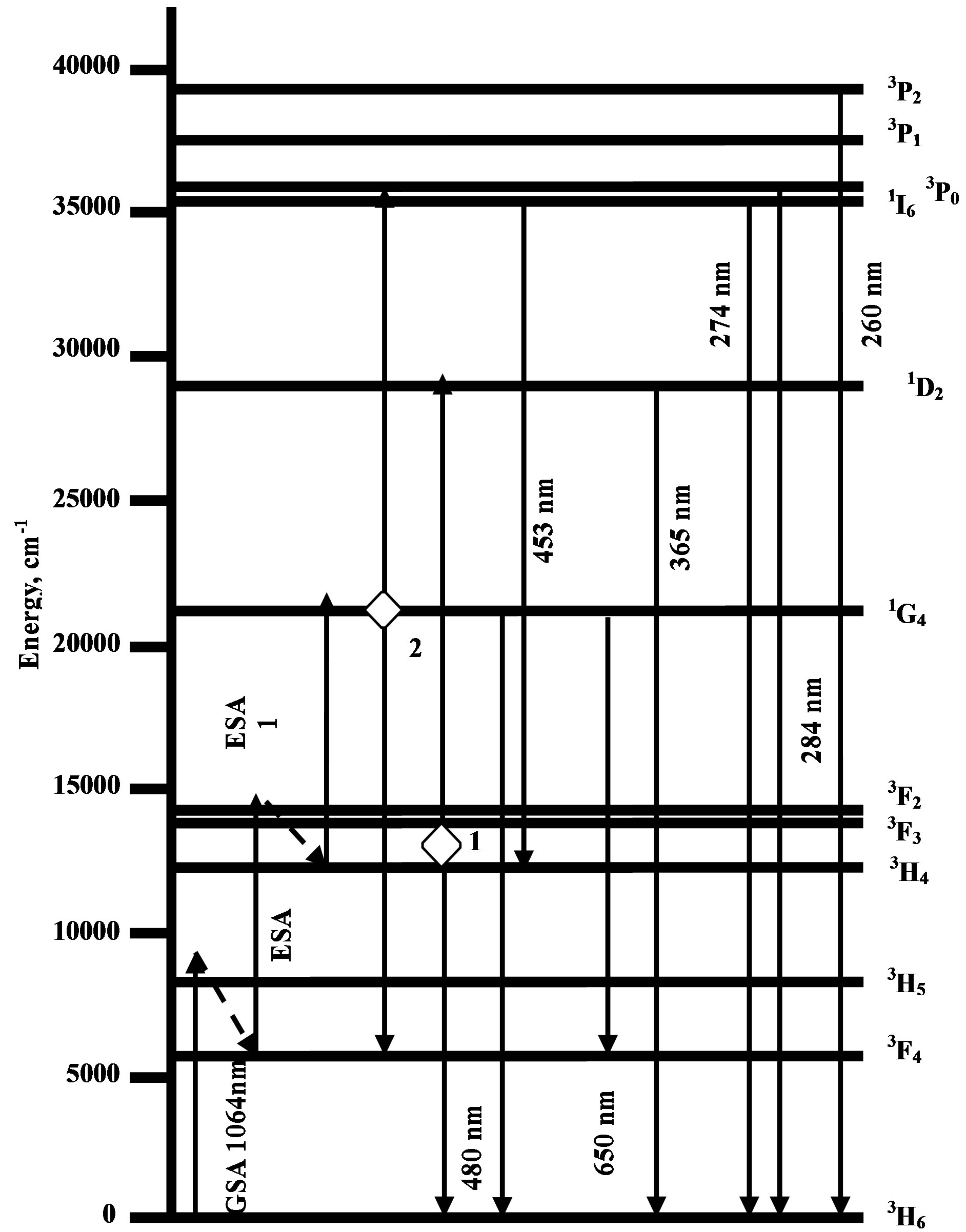
Figure 3. Shows energy level diagram for the 1% molar Tm+3-doped Zirconium fluoride glass [2] showing the excitation and up-conversion processes.
Figure 4 shows the measured emission up-conversion spectrum in 1% molar Tm+3-doped Zirconium fluoride glass under excitation wavelength of 1064 nm. The results show that broad up-conversion fluorescence band (from 260 to 650 nm). The peaks are at 260 nm (3P2 → 3H6), 274 nm (3P0 → 3H6), 284 nm (1I6 → 3H6), 365 (1D2 → 3H6), 453 nm (1I6 → 3H4), 480 nm (1G4 → 3H6) and 650 nm (1G4 → 3F4). The UV intensity of fluorescence emission originating from 1I6 level is magnified twenty times (×20). This intensity can be increased by increasing the dopant concentration to Tm+3. This will reduce the distance between Tm+3 ions resulting in efficient ETU processes and leading to a strong UV emissions [12,13].
In addition, the measurements of UV emissions originating from 1I6 level were taken in few seconds after excitation. The UV fluorescence emission was gradually reduced to the noise level due to formation of color centers and existence of photo-degradation. Usually, this effect can be eliminated almost totally by circulating blue light or wavelength of 514 nm through the fiber core [2,6].
The power dependence of up-conversion fluorescence originating from 1G4 level at (480 nm), 1D2 level at (365 nm) and 1I6 level at (453 nm) were measured by inserting different neutral density filters in the path of the pump
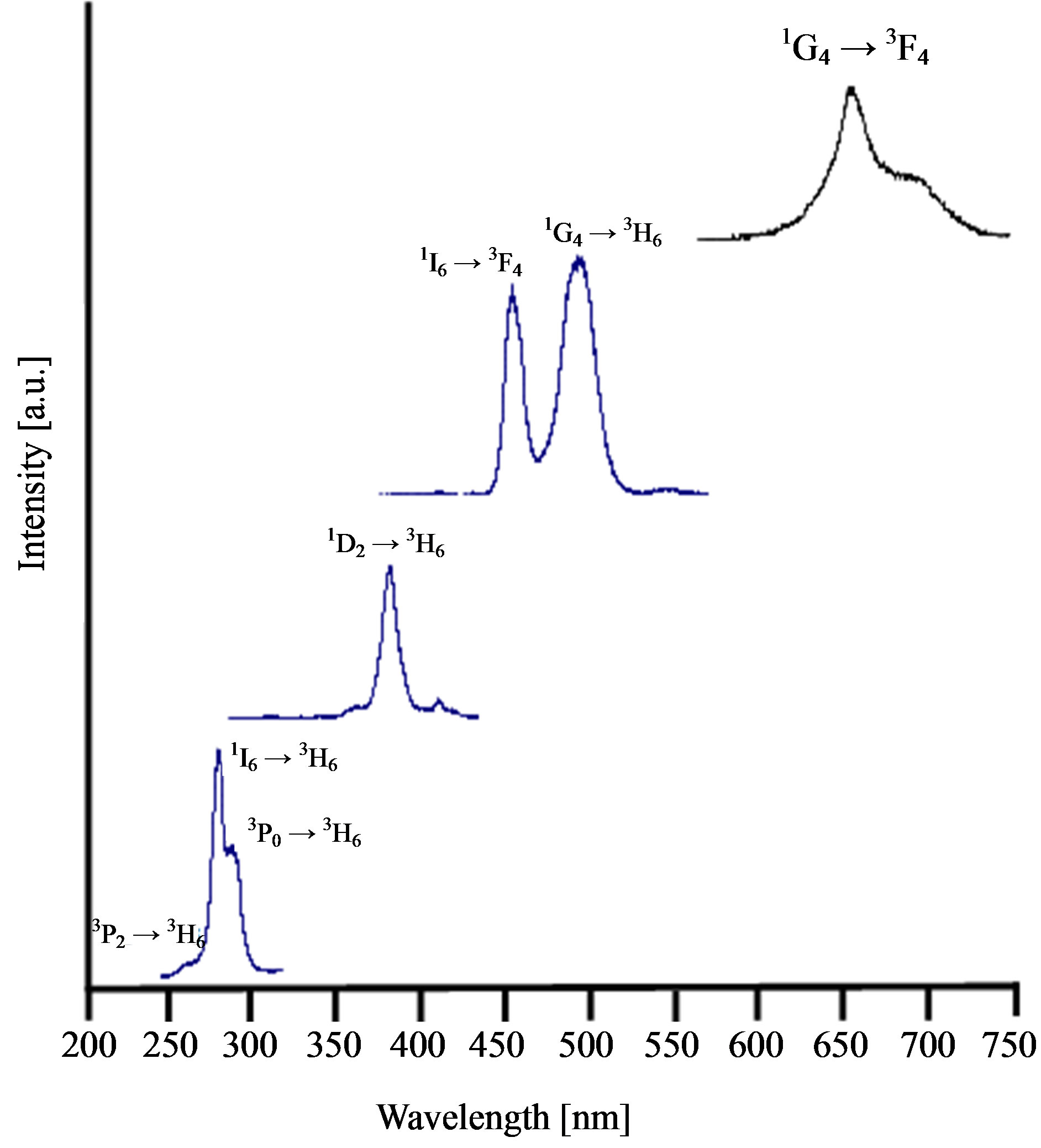
Figure 4. Up-conversion fluorescence spectra in 1% molar Tm+3-doped zirconium fluoride glass at a pump wavelength of 1.064 µm.
excitation. The wavelength-dependence of the experimental detection system (grating and photodiodes) was taken into account by calibration with the spectrum of a black body.
The experimental date have been fit to straight lines in double logarithmic scale with slope about 3 for (1G4 ® 3H6, l = 480 nm), ~4 for (1D2 ® 3H6, l = 365 nm) and ~6 for (1I6 ® 3H4, l = 453 nm). As can be seen in Figure 5 that the blue emission at 480 nm indicates three photon process is involved with slope 3 or fluorescence intensity (IFluor.) is proportional with pump intensity PPump (IFluor.a P3). Moreover, for emission at 365 nm with slopes 4 is considered to be 2 ESAs with 2 ions for ETU (arrow 1 in Figure 3) or IFluor.a P4. The up-conversion emission at 453 nm is also considered 3 ESAs and 2 ions for ETU (arrow 2 in fog. 2) or IFluor.a P6.
In order to determine and confirm the excitation mechanism of the up-conversion process, time resolved spectroscopy method is used to analyse the temporal behavior after pumping processes of the 453 nm and 480 nm transitions.
Figure 6 shows the temporal behavior of fluorescence decays at 480 nm and 453 nm. As can be seen in Figure 6 that, when the pump excitation is turned off the resulting fluorescence exhibits an exponential decay for 480 nm. Therefore, the mechanism of up-conversion fluorescence can be confirmed as ESA process. Whereas, upconversion fluorescence decay at 453 nm exhibits an initial rising phase. This is the typical behavior of ETU
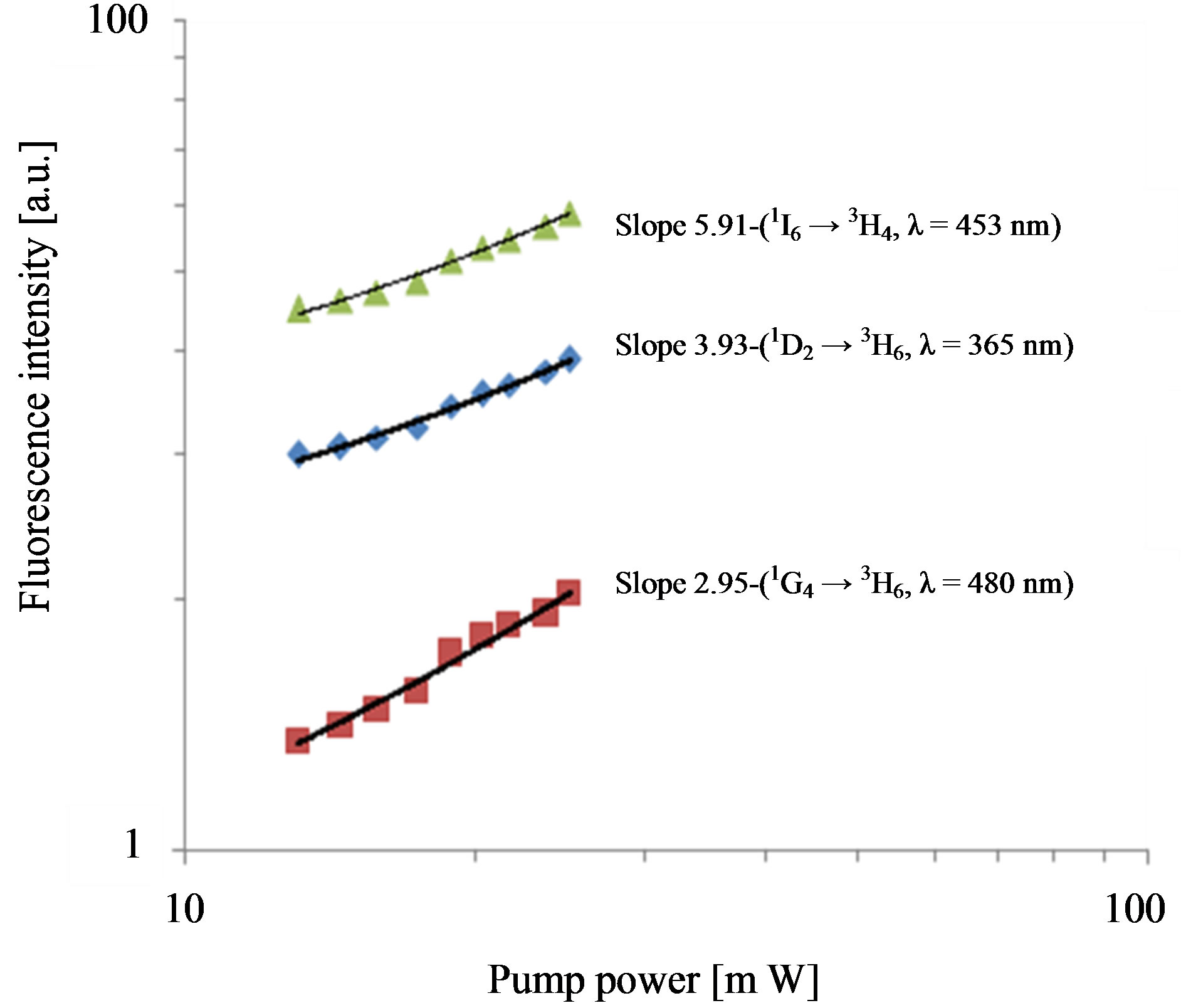
Figure 5. Power dependence of up-conversion fluorescence at 365, 453, and 480 nm at a pump wavelength of 1.064 µm.
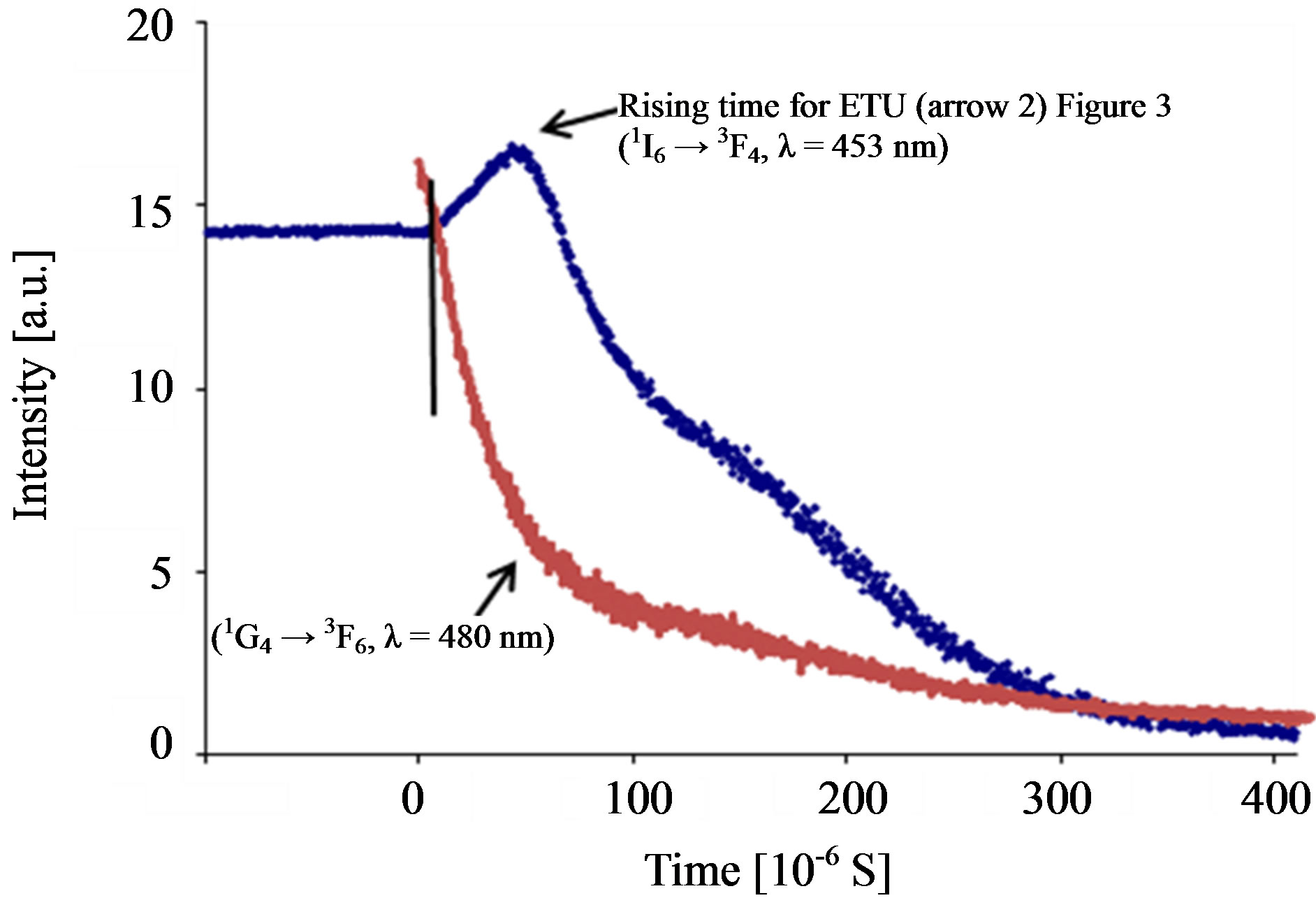
Figure 6. Tm+3: doped zirconium fluorescence dynamic monitored at 453 nm (1I6 ® 3H4) and 480 nm (1G4 ® 3H6) under up-conversion pumping at 1064 nm.
that takes place after the end of the excitation process and have an observable rise time.
As mentioned above the reduction in the fluorescence intensity after few minutes of appearance is mainly due to presence of color centers problem. The photo-curing of the photo-darkening effect is realized by directing a wavelength of a 514 nm on the side of length thought glass sample shown if Figure 1. The emitted UV fluorescence emissions did not affected potentially as presented in ref. [6] for fiber lasers. This mainly due to large pump area compared with fiber lasers.
4. Conclusion
In conclusion, we have identified experimentally the excitation mechanism of a (1% molar) Thulium (Tm+3)- doped Zirconium fluoride glass sample. The sample was pumped at 1064 nm. The dependence of up-conversion fluorescence intensity versus excitation power at 1064 nm and its temporal behavior have been investigated based on experimental data. The experimental data showed that three ESAs and ETUs processes 3H4, 3F2 ® 1D2, 3H6 & 1G4, 1G4 ® 1I6, 3F4. The related problem of photo-degradation associated with formation of color centers that has not been solved yet is also introduced. The presented date is very useful for producing short wavelength fiber lasers.
Acknowledgements
The author grateful thank to the Taif University-KSA for supporting this research work under award research grant no. 1850-433-1. Also a great thank to Dr. Maze (Le Verre Fluor, France) for loaning us the glass sample.
REFERENCES
- Z. Sun, R. Li, Y. Bi, X. Yang, Y. Bo, Y. Zhang, G. Wang, W. Zhao, H. Zhang, W. Hou, C. Dafu and Z. Xu, Optics Communications, Vol. 241, 2004, pp. 167-172. http://dx.doi.org/10.1016/j.optcom.2004.06.063
- F. J. Digonnet, “Rare Earth Doped Fiber Lasers and Amplifiers,” 2nd Edition, Dekker, New York, 2001. http://dx.doi.org/10.1201/9780203904657
- Y. J. Zhang, W. Wang, S. F. Song and Z. G. Wang, Laser Physics Letters, Vol. 6, 2009, pp. 723-726. http://dx.doi.org/10.1002/lapl.200910064
- H. B. Seereze and C. M. Harding, Electronics Letters, Vol. 28, 1992, pp. 2115-2116. http://dx.doi.org/10.1049/el:19921357
- J. Gao, F. Chen, X. D. Li, R. P. Yan, Z. Zhang, J. H. Yu and Y. Z. Wang, Laser Physics Letters, Vol. 5, 2008, p. 577. http://dx.doi.org/10.1002/lapl.200810027
- R. M. El-Agmy and N. M. Al-Hosiny, Laser Physics, Vol. 20, 2010, pp. 838-841. http://dx.doi.org/10.1134/S1054660X10070066
- R. M. El-Agmy, Laser Physics, Vol. 20, 2010, pp. 1990- 1993. http://dx.doi.org/10.1134/S1054660X10210048
- W. Tian and R. Reddy, Optics Letters, Vol. 26, 2001, pp. 1580-1582. http://dx.doi.org/10.1364/OL.26.001580
- J. Y. Allain, M. Monerie and H. Poignant, Electronics Letters, Vol. 26, 1990, pp. 166-168. http://dx.doi.org/10.1049/el:19900113
- G. Qin, S. Huang, Y. Feng, A. Shirakawa, M. Musha and K. I. Ueda, Applied Physics B, Vol. 82, 2006, pp. 65-70. http://dx.doi.org/10.1007/s00340-005-2042-8
- R. M. El-Agmy, Laser Physics, Vol. 18, 2008, pp. 803- 806. http://dx.doi.org/10.1134/S1054660X08060194
- G. Li, X. Wang and Z. Jiang, Optics Communications, Vol. 282, 2009, pp. 4249-4251. http://dx.doi.org/10.1016/j.optcom.2009.06.067
- J. Li, X. Wang, H. Yang and Z. Jiang, Physica B, Vol. 392, 2007, pp. 251-254. http://dx.doi.org/10.1016/j.physb.2006.11.029
- B. Frison, A. R. Sarmani, L. R. Chen, X. Gu and M. Saad, “Multi-Wavelength S-Band Tm+3:ZBLAN Fiber,” Conference Proceedings SPIE 8601, Technology Systems and Applications, San Francisco, 2 February 2013.
NOTES
*Corresponding author.

